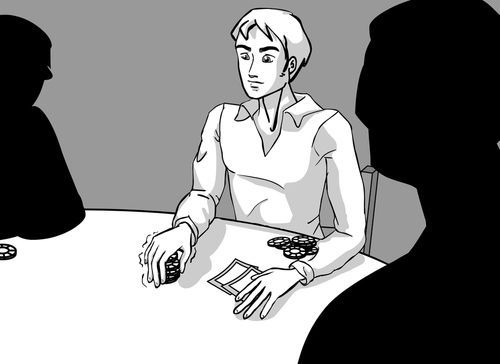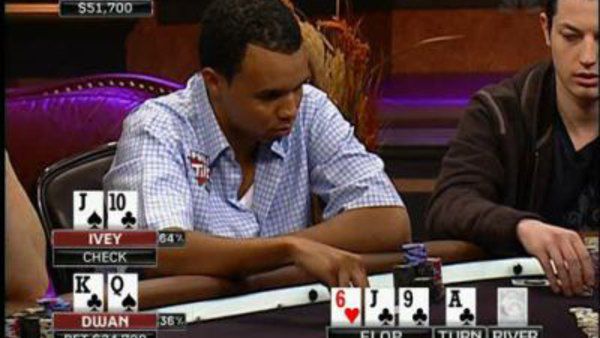A little bit more about postflop play in poker. Part 2

Let’s return to the discussion of psychological factors effecting postflop game in poker. If you missed the first article, you can find it here.
V. Control the size of the pot
This is really a much more difficult task than it might seem at first glance. Managing the pot size works in two directions: trying to make a little pot stay within certain size and do everything in your power to increase the size of the pot.
If you have a draw combination (incomplete poker hand that can improve to a very strong one) instead of a made hand, you’d better try to make your hand complete for a lowest price possible. More info about poker hands can be found at the article called 'No Limit Texas Hold'em hand rankings'
There are some simple ways of realization of the strategy. Blocking bet is one of them (a small sized bet that won’t let you opponent make a big bet). Or 'deliberate' check (after long thoughts) which will make your opponent think you have a strong hand or you’re planning on doing something weird, in result you opponent will have to check behind.
You don’t try to blow the pot even having top pair with a decent kicker. Don’t overestimate the strength of this combination in poker. Only bottom two pair can compete against top pair top kicker when it goes about the amount of chips lost with this or that combination in poker.
Your cards will often be a second best hand in big pots... having even one such fiasco during the session will give you a negative result in the long run.
The situation drastically changes in case you get a monster on the flop: in that case you have to be interested in winning the pot of as large as possible size.
Bets of half a pot or three quarters of a pot look good on flop and turn and commit players to the pot almost in all the cases.
More experienced players can use overbets (bets that are bigger than the current pot size). This line will work if you assessed the opponent and the whole situation correctly. You overbet should look like a bluff, otherwise your opponent won’t make the call.

VI. Attentively follow effective stack sizes
Beginners in poker often don’t even know what effective stack is so they bet disregarding the opponent’s stack size.
There are several rather simple principles. One of them - don’t be afraid to bluff into players with short stacks. If the player decided to look at the flop having around 10-20BB in his stack, he will rarely fold in response for your pushes. There are situations where he completely missed the flop and he is gong to fold (sometime it will be a correct decision). Under those circumstances, small bet will be as effective as a pot-size bet or a push.
It's not easy to force the player with the deep stack fold his cards and out of the pot. He is happy with his play and will continues to play with the hand he could have thrown away under other circumstances. Deep stacks increase the value of gutshots and small pairs. Those combinations are masked well and big stack will pay out your strong hand should you get your outs.
Value of these hands sufficiently decreases against short stacks.
At the certain stages of the tournament stack sizes effect on the gaming strategy increases (ITM bubble and final table bubble)
VII. Don’t try to guess the exact hand your opponent has. Assess his range and adjust this range with every new street
This simple conception might not be known by everyone so let’s have a detailed look on it. You can often hear phrases like 'I thought he had a flush draw' at the poker table or 'I was putting him on or at best'.
Sometimes those guesses are right but in most cases they are mistaken. The reasons of these mistakes are too straightforward assessment of the opponent in some cases and the result of too many poker programs on TV - more often.
Many players are amazed by the skills of Daniel Negreanu and Mike Matusow to read those masked hands of the opponents. This is really impressive when Daniel looking on the opponent says: 'OK, 9 is a doper for your Ace, I am way behind so I fold' and the camera shows the opponent has A9.

Before you will try to do these tricks yourself, think about the following things. Firstly, these guys are really strong players with huge experience. Secondly, their opponents are usually also professional whose game is studied. There is also one common type of the opponent. It is an amateur who is easy to read. Thirdly, you are watching TV show, which is edited in most cases.
It is very hard to define in online poker, which cards exactly does your opponent have. Besides, this is a wrong way to the opponents’ hand reading. You have to start with the range of hands, which is possible in the situation. Then you narrow this range using the information you get on the following streets.
If you started with a pocket pair or hit good hand on the flop, each new card will probably decrease the value of your hand. Complete hands often lose value, draws are able to improve.
Don’t forget to re-estimate at the opponent’s possible range, assessing his reaction for a new card on the table.
VIII. Float
Beginners rarely need this conception but we’ve decided to talk about it. Lately many players use it. This concept is effective against preflop raisers who didn’t improve on the flop. Despite the popularity of the concept grows, you should be careful implementing it into your game.
Let’s suppose, your opponent in the early position makes a standard raise preflop to 4BB. You call from BU with some mediocre hand. Not scary rainbow flop comes out, for instance . (see flop textures for more info)
Raiser, realizing you will rarely hit this board tries to win the pot using the continuation bet. You call representing a hand like 98s or 88.
If the layer has a strong Ace, he will often check on a blank turn. That way you will have an opportunity to get the pot with the help of the bet.
In this case you don’t look at your cards (as they are irrelevant), you play on your opponent’s weakness he showed by making a check.
Many players know this concept very well. If your opponent reads your bluff, he is able to outplay you with the check-raise. Don’t float too often. Choose opponents who like to fold. Reckless usage of floats will lead to losses while timely usage will increase your winrate.
Knowledge base's sections
The best about poker
- How to get satisfaction from playing poker
The psychology of poker
- Five reasons why I've made money and continue doing this playing poker
The psychology of poker
- Poker table positions (positions in poker)
Fundamentals of poker
- The fundamental theorem of poker
Poker theorems
- Slow play in poker
Fundamentals of poker
- The probabilities of getting specific starting hands on preflop
Poker mathematics
 pokerglobal
pokerglobal
Comments (0)